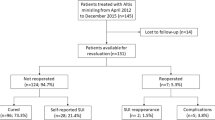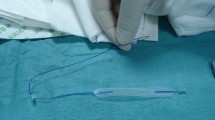Abstract
Introduction and hypothesis
Data on Altis® (Coloplast), a new adjustable single-incision sling (SIS) procedure for the treatment of female stress urinary incontinence (SUI), are scarce. Our aim was to evaluate the efficacy and complication rates of this procedure.
Methods
In this prospective observational study, a total of 52 women with SUI were implanted with an Altis® sling in an ambulatory setting. Before and after intervention (3, 6, and 12 months), women completed the International Consultation on Incontinence Questionnaire Short Form (ICIQ-SF). In addition, patients underwent a cough stress test at each evaluation and a post-voiding residual urine volume estimation at 3 months. The main outcomes measured were subjective cure (ICIQ-SF = 0), subjective improvement (ICIQ-SF >0 and < preoperative ICIQ-SF), and objective cure (negative cough stress test and no pad usage) rates. De novo overactive bladder (OAB) symptoms, changes in voiding habits and adverse events were also analyzed.
Results
The subjective cure rate at 12 months was 84.0 %, with an additional improvement rate of 8.0 %. The objective cure rate was 90.2 %. Later postoperative complications included 1 case of vaginal extrusion (requiring surgical removal of the eroded mesh segment), 3 cases of vaginal exposure of the adjustment thread (managed conservatively), de novo urgency in 3 patients, and mild dyspareunia in 2 patients.
Conclusions
The Altis® sling is a safe and effective SIS procedure for the treatment of SUI with a short-term follow-up.

Similar content being viewed by others
References
Norton P, Brubaker L (2006) Urinary Incontinence in women. Lancet 367(9504):57–67
Hunskaar S, Lose G, Sykes D, Voss S (2004) The prevalence of urinary incontinence in women in four European countries. BJU Int 93(3):324–330
Nilsson CG, Palva K, Rezapour M, Falconer C (2008) Eleven years prospective follow-up of the tension-free vaginal tape procedure for treatment of stress urinary incontinence. Int Urogynecol J 19(8):1043–1047
Moore RD, Serels SR, Davila GW, Settle P (2009) Minimally invasive treatment for female stress urinary incontinence (SUI): a review including TVT, TOT, and mini-sling. Surg Technol Int 18:157–173
Cornu JL, Sèbe P, Peyrat L, Ciofu C, Cussenot O, Haab F (2010) Midterm prospective evaluation of TVT-Secur reveals high failure rate. Eur Urol 58(1):156–161
Meschia M, Barbacini P, Ambrogi V, Pifarotti P, Ricci L, Spreafico L (2009) TVT-Secur: a minimally invasive procedure for the treatment of primary stress urinary incontinence. one year data from a multi-centre prospective trial. Int Urogynecol J Pelvic Floor Dysfunct 20(3):313–317
Debodinance P, Lagrange E, Amblard J et al (2008) TVT Secur: more and more minimally invasive. Preliminary prospective study of 110 cases. J Gynecol Obstet Biol Reprod 37(3):229–236
Meschia M, Barbacini P, Baccichet R et al (2011) Short-term outcomes with the Ajust system: a new single incision sling for the treatment of stress urinary incontinence. Int Urogynecol J 22(2):177–182
Abdel-Fattah M, Agur W, Abdel-All M et al (2011) Prospective multi-centre study of adjustable single-incision mini-sling (Ajust) in the management of stress urinary incontinence in women: 1-year follow-up study. BJU Int 109(6):880–886
Cornu JN, Peyrat L, Skurnik A, Ciofu C, Lucente VR, Haab F (2012) Ajust single incision transobturator sling procedure for stress urinary incontinence: results after 1-year follow-up. Int Urogynecol J 23:1265–1270
Mostafa A, Agur W, Abdel-All M et al (2012) A multicentre prospective randomised study of single-incision mini-sling (Ajust®) versus tension-free vaginal tape-obturator (TVT-OTM) in the management of female stress urinary incontinence: pain profile and short-term outcomes. Eur J Obstet Gynecol Reprod Biol 165(1):115–121
Mostafa A, Agur W, Abdel-All M et al (2013) Multicenter prospective randomized study of single-incision mini-slings vs. tension-free vaginal tape-obturator in management of female stress urinary incontinence: a minimum of 1-year follow-up. Urology 82(3):552–559
Dias J, Freitas R, Amorim R, Xambre L, Costa L, Ferraz L (2013) Altis® single-incision sling procedure for stress urinary incontinence: short term outcomes from a single centre. Eur Urol Suppl 12:e895
Tamanini J, Dambros M, D’Ancona C, Palma P, Netto N Jr (2004) Validation of the “International Consultation on Incontinence Questionnaire—Short Form” (ICIQ-SF) for Portuguese. Rev Saude Publica 38(3):1–6
Amid PK (1997) Classification of biomaterials and their related complications in abdominal wall hernia surgery. Hernia 1(1):15–21
Haylen BT, Freeman RM, Swift SE et al (2011) An International Urogynecological Association (IUGA)/ International Continence Society (ICS) joint terminology and classification of the complications related directly to the insertion of prostheses (meshes, implants, tapes) and grafts in female pelvic floor surgery. Int Urogynecol J 22:3–15
Gauruder-Burmester A, Popken G (2009) The MiniArc Sling System in the treatment of female stress urinary incontinence. Int Braz J Urol 35(3):334–343
Moore RD, Mitchell GK, Miklos JR (2009) Single-center retrospective study of the technique, safety, and 12-month efficacy of the MiniArc single-incision sling: a new minimally invasive procedure for treatment of female SUI. Surg Technol Int 18:175–181
Moalli PA, Papas N, Menefee S, Albo M, Meyn L, Abramowitch SD (2008) Tensile properties of five commonly used mid-urethral slings relative to the TVT. Int Urogynecol J Pelvic Floor Dysfunct 19(5):655–663
Rezapour M, Novara G, Meier PA, Holste J, Landgrebe S, Artibani W (2007) A 3-month preclinical trial to assess the performance of a new TVT-like mesh (TVTx) in a sheep model. Int Urogynecol J 18(2):183–187
Basu M, Duckett J (2010) A randomised trial of retropubic tension-free vaginal tape versus a mini-sling for stress urinary incontinence. BJOG 117(6):730–735
Murphy M, Culligan PJ, Arce CM et al (2005) Is the cough test necessary when placing the tension-free vaginal tape? Obstet Gynecol 105(2):319–324
Koops SE, Bisseling TM, van Brummen HJ, Heintz AP, Vervest HA (2006) What determines a successful tension free vaginal tape? A prospective multicentre cohort study: results from the Netherlands TVT database. Am J Obstet Gynecol 194(1):65–74
Holmgren C, Nilsson S, Lanner L, Hellberg D (2005) Long-term results with tension-free vaginal tape on mixed and stress urinary incontinence. Obstet Gynecol 106(1):38–43
Long CY, Hsu CS, Wu MP, Liu CM, Wang TN, Tsai EM (2009) Comparison of tension-free vaginal tape and transobturator tape procedure for the treatment of stress urinary incontinence. Curr Opin Obstet Gynecol 21(4):342–347
Oliveira R, Botelho F, Silva P et al (2011) Single-incision sling system as primary treatment of female stress urinary incontinence: prospective 12 months data from a single institution. BJU Int 108(10):1616–1621
Ulmsten U, Flaconer C, Johnson P et al (1998) A multicenter study of tension-free vaginal tape (TVT) for surgical treatment of stress urinary incontinence. Int Urogynecol J Pelvic Floor Dysfunct 9(4):210–213
Waltregny D, de Leval J (2009) The TVT-obturator surgical procedure for the treatment of female stress urinary incontinence: a clinical update. Int Urogynecol J Pelvic Floor Dysfunct 20(3):337–348
Kennelly MJ, Moore RD, Nguyen JN, Lukban J, Siegel S (2012) Miniarc single-incision sling for treatment of stress urinary incontinence: 2-year clinical outcomes. Int Urogynecol J 23(9):1285–1291
Abdel-Fattah M, Mustafa A, Familusi A, Ramsay I, N’dow J (2012) Prospective randomized controlled trial of transobturator tapes in management of urodynamic stress incontinence in women: 3-year outcomes from the Evaluation of Transobturator Tapes study. Eur Urol 62(5):843–851
Acknowledgements
Conflicts of interest
None.
Contribution to the manuscript
J. Dias: project development, data collection, data analysis, manuscript writing.
L. Xambre: project development, data management, manuscript editing.
L. Costa: manuscript editing.
P. Costa: data collection.
L. Ferraz: manuscript editing.
Author information
Authors and Affiliations
Corresponding author
Rights and permissions
About this article
Cite this article
Dias, J., Xambre, L., Costa, L. et al. Short-term outcomes of Altis® single-incision sling procedure for stress urinary incontinence: a prospective single-center study. Int Urogynecol J 25, 1089–1095 (2014). https://doi.org/10.1007/s00192-014-2355-4
Received:
Accepted:
Published:
Issue Date:
DOI: https://doi.org/10.1007/s00192-014-2355-4




